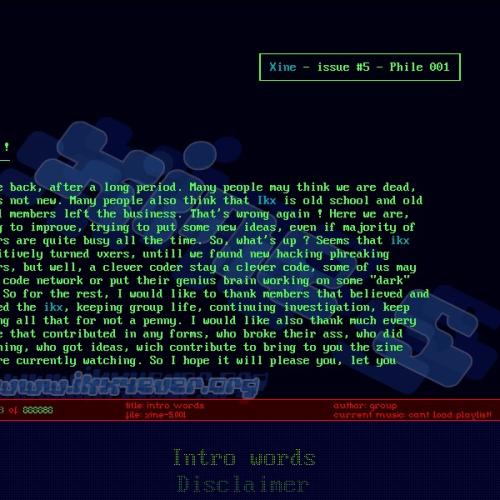Copy Link
Add to Bookmark
Report
AIList Digest Volume 5 Issue 212

AIList Digest Friday, 11 Sep 1987 Volume 5 : Issue 212
Today's Topics:
Queries - AAAI Presidential Address Recordings & LISP/VM &
PD OPS5 & LISP Chess Program & Conceptual Graphs &
Neural Network Email Addresses,
Philosophy - Is Computer Science Science? & Leibniz on Philosophy,
Neural Networks - Unaligned Fields & Speech Analysis
----------------------------------------------------------------------
Date: Thu, 10 Sep 87 12:08:17 PDT
From: AAAI <AAAI-OFFICE@SUMEX-AIM.STANFORD.EDU>
Subject: HELP!
During AAAI-87, we normally tape the Presidential Address by Pat Winston.
This year, the tapes were scrambled. If anyone made a tape of Patrick
talk, we would really appreciate if we could receive a copy?
Also, Marvin Minsky has asked us if anyone still has retained a tape
of his 1982 Presidential Address in Pittsburgh. He would also like
a copy, if it is still available.
Thank you for any help you may provide.
Sincerely,
Claudia Mazzetti
AAAI
445 Burgess Drive
Menlo Park, CA 94025
------------------------------
Date: Tue, 08 Sep 87 12:46:31 FIN
From: Heikki Pesonen <LK-HPE%FINOU.BITNET@wiscvm.wisc.edu>
Subject: LISP/VM
=========================================================================
I will be pleased to here peoples opinion about IBM:s LISP/VM.
We have it, but not many seems to be interested in it. I like it,
so what is wrong with LISP/VM? What is good with it?
We have LISP/VM to the end of this year, not longer, if it do not
interest people more (I am afraid of ..).
Unfortunately LISP/VM is not very compatible with Common Lisp and its
usually slow in our IBM 3083 VM/CMS, but it has many usefull features.
Becouse I am no Lisp Guru I would like to get the opinions of those
who are. I know that LispGurus usually reside near a Lispmachine
/Xerox etc.) and they do not appreciate mainframe lisps. So may be
a vain effort ..
Yours sincerely, Heikki Pesonen, EDP-Centre,
University of Oulu, 90570 OULU, Finland
========================================================================
------------------------------
Date: 9 Sep 87 00:28:26 GMT
From: clyde!watmath!utgpu!tmsoft!mason@RUTGERS.EDU (Dave Mason)
Subject: Is there a Public Domain/Shareware version of OPS5 ?
A colleague of mine is interested in this for a Comparative Languages
course & an Expert Systems course. Any leads appreciated.
Thanks
../Dave Mason, Ryerson Polytechnical Institute
best: ..!{utzoo seismo!mnetor utcsri utgpu lsuc}!tmsoft!mason
FCTY7053@RYERSON.BITNET
------------------------------
Date: Thu, 10 Sep 87 14:29:09 cdt
From: Glenn Manuel <manuel%home%ti-csl.csnet@RELAY.CS.NET>
Reply-to: Glenn Manuel <home!manuel%ti-csl.csnet@RELAY.CS.NET>
Subject: Wanted: LISP Chess Program
Does anyone know of a pretty good Chess program written in LISP,
either commercially available or (preferably) public domain?
I'll be running it on a TI Explorer driving an external display
(possibly a dumb terminal via RS-232 -- don't ask why), so I'm
mostly interested in the algorithms, not fancy graphics for
displaying the game pieces.
Thanks in advance,
--
Glenn Manuel (214) 575-5231
Texas Instruments, Inc., PO Box 869305 MS 8473, Plano, Tx. 75086
USENET: {ctvax,im4u,texsun,rice}!ti-csl!manuel CSNET: Manuel@TI-CSL
------------------------------
Date: 9 Sep 87 22:35:25 GMT
From: plx!titn!jordan@sun.com (Jordan Bortz)
Subject: conceptual graphs
Has anyone played with Conceptual Networks, as documented in
Conceptual Structures, by Sowa? In what language? What kinds of
things did you try to implement? How did it work?
Jordan
--
=============================================================================
Jordan Bortz Higher Level Software 1085 Warfield Ave Piedmont, CA 94611
(415) 268-8948 UUCP: (decvax|ucbvax|ihnp4)!decwrl!sun!plx!titn!jordan
=============================================================================
------------------------------
Date: 10 Sep 87 23:15:30 GMT
From: jr@io.att.com (j.ratsaby)
Subject: Need email names
I would like to get email names of persons who deal with neural-nets
in CS dept of university of Toronto and/or in CS dept of John Hopkins
university in Baltimore.
thanks in advance,
joel
------------------------------
Date: 8 Sep 87 16:53:54 GMT
From: decvax!sunybcs!rapaport@ucbvax.Berkeley.EDU (William J.
Rapaport)
Subject: Is Computer Science Science?
A colleague of mine in a philosophy department recently asked me if
I could give him "some major causal laws, principles or regularities
that are special to Computer Science.... (Every science has its special
laws, so what are some for Computer Science?)"
I vaguely recall a recent discussion on one of the nets about this. If so,
is there some way I could get a copy of it (hard or soft)? If not,
would anyone like to take a stab at answering this?
William J. Rapaport
Assistant Professor
Dept. of Computer Science, SUNY Buffalo, Buffalo, NY 14260
(716) 636-3193, 3180
uucp: ..!{ames,boulder,decvax,rutgers}!sunybcs!rapaport
csnet: rapaport@buffalo.csnet
internet: rapaport@cs.buffalo.edu
[if that fails, try: rapaport%cs.buffalo.edu@cs.relay.net]
bitnet: rapaport@sunybcs.bitnet
------------------------------
Date: 10 Sep 87 05:38:05 GMT
From: voder!apple!corwin@ucbvax.Berkeley.EDU (Entomology Lab)
Subject: Re: Is Computer Science Science?
In article <5113@sunybcs.UUCP> rapaport@sunybcs.UUCP (William J. Rapaport)
writes:
>
>A colleague of mine in a philosophy department recently asked me if
>I could give him "some major causal laws, principles or regularities
>that are special to Computer Science.... (Every science has its special
>laws, so what are some for Computer Science?)"
>
"Anything that can go wrong will go wrong."
"There is always one more bug"
"The differnce between a bug and a feature is that a feature is documented"
-cory
--
corwin@apple.[UUCP, CSNET]
Disclaimer: The preceding message is not based on reality.
------------------------------
Date: 10 Sep 87 23:48:20 GMT
From: shafto@ames-aurora.arpa (Michael Shafto)
Subject: Re: Is Computer Science Science?
I just saw a tech report by Peter J. Denning on the topic
"Is computer science science?"
The tech report was issued through RIACS here at Ames.
It will allegedly appear as an editorial in the Oct., 1987,
CACM. The title is something like "Paradigms Crossed" --
referring to the crossed paradigms of design vs. experimentation,
or engineering vs. science.
I would rate this "real good" on a scale of 1 to 10, and I
urge interested parties to watch for and read it.
Mike Shafto
------------------------------
Date: 9 Sep 87 00:37:12 GMT
From: psuvax1!vu-vlsi!ge-mc3i!sterritt@husc6.harvard.edu (Chris
Sterritt)
Subject: Re: Leibniz on philosophy
In article <17172@glacier.STANFORD.EDU> jbn@glacier.STANFORD.EDU
(John B. Nagle) writes:
> "Philosophy is the discipline where you kick up a lot of dust and then
>complain you can't see."
As long as we're slamming philosophy, why not:
"Philosophy is a blind man in a dark room looking for a black cat...
THAT ISN'T THERE"
------------------------------
Date: 9 Sep 87 13:54:23 GMT
From: PT!cadre!geb@cs.rochester.edu (Gordon E. Banks)
Subject: Re: Neural Networks & Unaligned fields
In article <3523@venera.isi.edu> smoliar@vaxa.isi.edu.UUCP
(Stephen Smoliar) writes:
>In article <277@ndmath.UUCP> milo@ndmath.UUCP (Greg Corson) writes:
>>Ok, here's a quick question for anyone who's getting into Neural Networks.
>>If you setup the type of network described in BYTE this month, or the
>>type used in the program recently posted to the net, what happens if you
>>feed it an input image that is not aligned right?
I didn't see the Byte article, but the simple neural networks that
I have seen (such as the one that solves the T-C problem by Hinton
& Rummelhart in the PDP book) do not generalize very well. You can
train the hidden units with a given input, but then if you shift the
pattern, it won't work. I asked Rummelhart about this, and he said
that once the hidden units develop the patterns (such as edge detectors
and center-surround, etc.) you do not need to retrain for each translation
of the pattern, but you need to add more units to the network. These
units have the same weights as the previously trained units, but they
have a different field of view. You have to have another set of units
for each region which can possibly contain the image. Alternatively,
you have to have a scheme for making sure the image is "centered" in
the field of view. Sounds like there is some room for interesting
research here, maybe a thesis.
------------------------------
Date: 9 Sep 87 15:00:36 GMT
From: caasi%sdsu.UUCP@sdcsvax.ucsd.edu (Richard Caasi)
Subject: Re: neural net conference
In response to those who asked and because email didn't work too well,
there was a session devoted to Speech Recognition and Synthesis at the
neural net conference (San Diego, June '87).
The papers were:
Issues and Problems in Speech Processing with Neural Networks
Learning Phonetic Features Using Connectionist Networks: An
Experiment in Speech Recognition
A Neural Network Model for Speech Recognition Using the Generalized
Delta Rule for Connection Strength Modification
Neural Networks for the Auditory Processing and Recognition of Speech
Multilayer Perceptrons and Automatic Speech Recognition
Neural Net Classifiers Useful for Speech Recognition
Isolated Word Recognition with an Artificial Neural Network
Recent Developments In a Neural Model of Real-Time Speech Analysis and
Synthesis
Concentrating Information in Time: Analog Neural Networks with
Possible Applications to Speech Recognition
Guided Propagation Inside a Topographic Memory
The Implementation of Neural Network Technology
------------------------------
End of AIList Digest
********************























